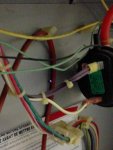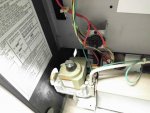I have a quick question. We bought a raypak 407a a few years ago, and it's been great! But we haven't been able to get it to start. I think it might be a simple fix, but am unsure of who to ask as there aren't any service techs near us.
When we start the heater, it says 'Spark', then, eventually faults to 'No Pilot Sensed'. 'Ignition Failure'.
What worried me is that I also saw that a red housing was sparking alongside our heater (burnt a hole through it), each time the spark tried to ignite.
When we moved the tubing away from the heater to see if it was shorting, the red tube didn't light up against our heater!... But we still had the same issue.
We have been trying to get this working for months, but are unsure of which documentation to follow to try and get it working again. Is this just a simple clean?
What happens:
-We turn the heater on
-It starts up, the display says Off
-We hit spa or pool temperature, maybe 2 or 3 clicks from different parts of the heater
-It says Spark, and we hear 3 even clicks, with about 2 second break, then it repeats forever
-Eventually it says No Pilot Sensed, Ignition Failure. It still clicks
-No flame is seen, we always hear clicks, gas is on we believe bc it's an extremely faint smell when we cycle gas off to on to test.
Thank you! (I attached a picture below of the spark.)
Our Fault List (Most Recent to Furthest)
-No Pilot Sensed
-No Pilot Sensed
-No Pilot Sensed
-No Pilot Sensed
-Water SW Open
-Water SW Open
-No Pilot Sensed
-Water SW Open
-No Pilot Sensed
-Water SW Open


When we start the heater, it says 'Spark', then, eventually faults to 'No Pilot Sensed'. 'Ignition Failure'.
What worried me is that I also saw that a red housing was sparking alongside our heater (burnt a hole through it), each time the spark tried to ignite.
When we moved the tubing away from the heater to see if it was shorting, the red tube didn't light up against our heater!... But we still had the same issue.
We have been trying to get this working for months, but are unsure of which documentation to follow to try and get it working again. Is this just a simple clean?
What happens:
-We turn the heater on
-It starts up, the display says Off
-We hit spa or pool temperature, maybe 2 or 3 clicks from different parts of the heater
-It says Spark, and we hear 3 even clicks, with about 2 second break, then it repeats forever
-Eventually it says No Pilot Sensed, Ignition Failure. It still clicks
-No flame is seen, we always hear clicks, gas is on we believe bc it's an extremely faint smell when we cycle gas off to on to test.
Thank you! (I attached a picture below of the spark.)
Our Fault List (Most Recent to Furthest)
-No Pilot Sensed
-No Pilot Sensed
-No Pilot Sensed
-No Pilot Sensed
-Water SW Open
-Water SW Open
-No Pilot Sensed
-Water SW Open
-No Pilot Sensed
-Water SW Open



